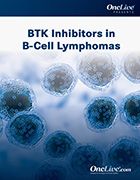Publication
Article
Supplements and Featured Publications
Leslie Breaks Down the Growing Importance of BTK Inhibitors in B-Cell Malignancies
Author(s):
Lori A. Leslie, MD, highlights ibrutinib, acalabrutinib, and zanubrutinib, the 3 FDA approved BTK inhibitors that have become very important weapons in the treatment arsenal for B-cell malignancies.
Lori A. Leslie, MD

Ibrutinib (Imbruvica), acalabrutinib (Calquence), and zanubrutinib (Brukinsa), the 3 FDA approved BTK inhibitors, have become very important weapons in the treatment arsenal for B-cell malignancies, according to Lori A. Leslie, MD, who added that future research efforts should focus on overcoming resistance and findings ways to deliver these agents in a time-limited fashion.
“BTK inhibitors are a group of drugs that inhibit the BTK enzyme involved in B-cell receptor signaling,” Leslie explained. “There are several approved indications [for these agents], including chronic lymphocytic leukemia (CLL), small lymphocytic lymphoma, marginal zone lymphoma, mantle cell lymphoma (MCL), and even Waldenström macroglobulinemia, a rare lymphoplasmacytic lymphoma. The 3 FDA-approved BTK inhibitors are currently undergoing further investigation.”
In an interview with OncLive, Leslie, a lymphoma attending at John Theurer Cancer Center (JTCC), Hackensack Meridian Health, highlighted the role of BTK inhibitors, including the recent approval of zanubrutinib, in B-cell malignancies.
OncLive: How do the 3 FDA approved BTK inhibitors compare with one another?
Leslie: The FDA BTK inhibitors have slightly different specificity in terms of how they target BTK. Approved BTK inhibitors for CLL and MCL include ibrutinib and acalabrutinib. To date, zanubrutinib has only been approved for relapsed/refractory MCL.
None of these agents can overcome resistance to 1 of the other BTK inhibitors. Additionally, due to the specificity of BTK, in addition to the potential off-target effects, these agents have different toxicity profiles. The dosing of the agents also differs. Ibrutinib is given once daily, acalabrutinib is given twice daily, and, per the FDA-approved dosage, zanubrutinib can be given either once or twice daily.
Some other differences between zanubrutinib and acalabrutinib exist in terms of the use of concomitant medications. One that commonly comes up are proton-pump inhibitors (PPIs), which are used for acid reflux.
How do you approach using these agents in practice?
As more options are made available, it's becoming an increasingly optimistic environment for patients; however, it’s also becoming increasingly complex. If I'm seeing a patient with CLL, for example, the top choices are ibrutinib and acalabrutinib.
If there had been a study comparing those 2 directly and we knew which was the optimal therapy, it would be an easier conversation. However, available data suggest that the efficacy is comparable between the agents.
In relapsed/refractory MCL, we have zanubrutinib to add to the mix, which makes the conversation even more complex. Ibrutinib has been around the longest; thus, it has the longest follow-up data available. Zanubrutinib, on the other hand, was recently approved so we don’t have as much follow-up data.
Although patients will ask us what we would typically recommend, there is not a clear answer. These agents are all thought to be very effective. [We don’t have clear data to suggest] that 1 agent is more effective than another.
Could you highlight some studies in this space that you are excited about?
The phase 3 ASPEN study, which looked at patients with relapsed/refractory Waldenströmmacroglobulinemia, has been helpful in this space. Those patients were treated with either ibrutinib or zanubrutinib. A slightly higher rate of very good partial response was observed in patients who received zanubrutinib over those who were given ibrutinib, which was the primary end point of the study.
The most helpful part of this research was the [fact that we saw] differing toxicity profiles. One main concern that we have with BTK inhibitors is the rate of atrial arrhythmias, particularly atrial fibrillation, increased bleeding due to the platelet collagen interaction, interference from BTK inhibitors, and also some gastrointestinal toxicity. In a direct comparison, at least in patients with Waldenström macroglobulinemia, the rates were numerically lower in patients who received zanubrutinib over ibrutinib.
The ELEVATE R-R trial is another ongoing study that is comparing ibrutinib with acalabrutinib in patients with high-risk relapsed/refractory CLL; however, we do not have any data available yet. The research should also be very interesting, not only for efficacy insights. There has been a need for a head-to-head comparison [between these agents] in this space.
How has zanubrutinib benefited other blood cancers?
The recent approval of the agent in MCL was a breakthrough. I believe we will see other approvals [with zanubrutinib] in the near future. We may see [indications for use in patients with] Waldenströmmacroglobulinemia, following data from the ASPEN trial, as well as in those with CLL. Data are emerging rapidly and it's becoming increasingly complicated to figure out which agents to use.
How has the approval of zanubrutinib impacted the MCL paradigm?
Now that the agent is available, it is competing with other available BTK inhibitors, including ibrutinib and acalabrutinib. In my particular practice, [zanubrutinib] hasn't dramatically changed the MCL treatment landscape; however, it has provided more flexibility.
The once-daily versus twice-daily dosing is more convenient for patients depending on their situation and it also may be better tolerated. Also, I can give zanubrutinib with PPIs for patients with acid reflux, which is a common comorbidity.
How do you approach sequencing zanubrutinib in your own practice?
I only use zanubrutinib in clinical trial settings that are evaluating patients who are intolerant to a different BTK inhibitor. Many clinical trials are ongoing.
In my practice, I use the agent for patients who need to avoid ibrutinib or acalabrutinib [as the former could provide] a potential decreased risk of cardiac or bleeding adverse effects. However, this depends on what other medications they're on, access, and cost. These agents are very expensive. All the companies that I've worked with have wonderful patient assistance programs but, even so, there can be significant co pays. Sometimes the choice is based on which is more affordable. Financial toxicity is not spoken about much; however, it’s just as important.
What are some unanswered questions with these agents that still need to be addressed?
One question in terms of BTK inhibitors is how to overcome resistance. If patients develop a mutation in the BTK binding site, commonly called a C481 mutation, the currently approved BTK inhibitors may not [be effective]. Several trials are in development to overcome this resistance [challenge].
Next, in most of these diseases or types of B-cell lymphoma, BTK inhibitor therapy is indefinite. We're now looking at ways to combine or consolidate patients who have achieved a good response to BTK inhibition and are not minimal residual disease negative to figure out how we can offer them time-limited therapy with these inhibitors, rather than indefinite treatment. This becomes very important, especially when diagnosing patients at younger ages.










